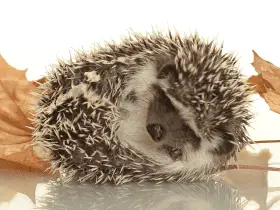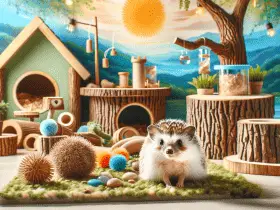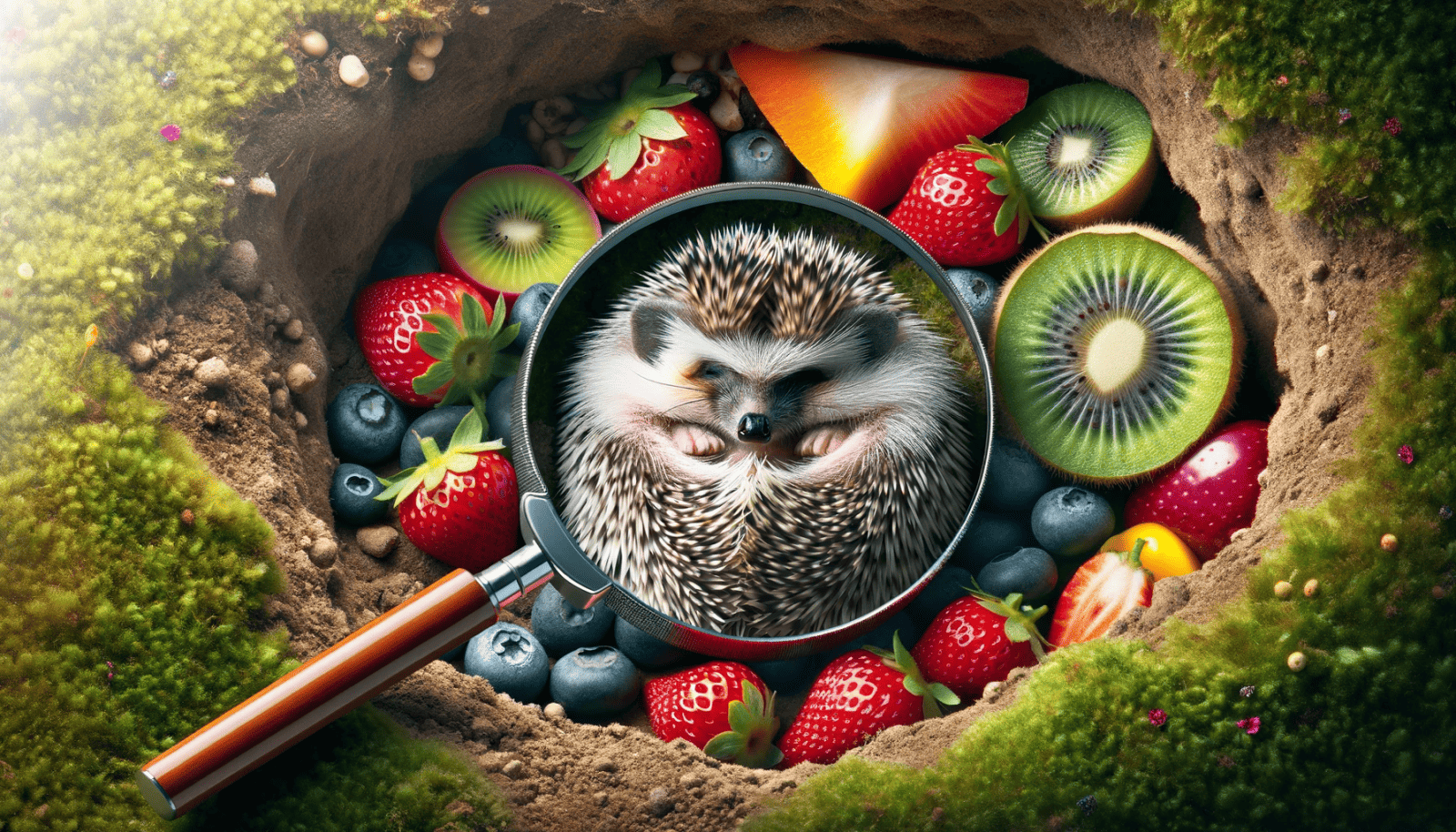Are you ready to explore the fascinating world of hedgehogs? In this in-depth article, we will debunk common misconceptions and provide you with a wealth of facts about these spiky creatures.
From their natural habitat and diet to their unique quills and behaviors, we’ll cover it all.
Whether you’re a hedgehog enthusiast or simply curious, get ready to dive into the intriguing world of hedgehog info and discover the truth behind the myths.
Let’s get started!
Key Takeaways
- Hedgehogs are adaptable to different climates and can be found in forests, meadows, and gardens.
- Their diet consists of dry cat food, insects, and fruits/vegetables, providing them with essential nutrients and dental health.
- Common health issues in hedgehogs include dental problems, obesity, respiratory infections, and mite infestations.
- Hedgehogs have a lifespan of 4 to 6 years in the wild, but can live up to 8 years or longer in captivity with proper care and regular veterinary check-ups.
The Hedgehog’s Natural Habitat
You’ll find hedgehogs in a variety of habitats, including forests, meadows, and gardens. Hedgehogs are adaptable creatures and have developed certain adaptations to survive in different climates. One of the reasons hedgehogs are found in a variety of habitats is due to their ability to adapt to different environmental conditions.
Hedgehogs are known for their spiky exterior, which acts as a defense mechanism against predators. These spines, called quills, are made of keratin and provide protection to the hedgehog’s soft body. In colder climates, hedgehogs have developed a unique adaptation to survive the harsh winters. They undergo a process called hibernation, where their body temperature drops significantly, and they enter a state of dormancy to conserve energy.
Hedgehog conservation efforts are crucial in maintaining the population of these adorable creatures. Loss of natural habitat due to urbanization and deforestation poses a threat to their survival. Efforts are being made to create wildlife corridors and protected areas to ensure hedgehogs have suitable habitats to thrive.
Hedgehog Diet and Feeding Habits
Feeding a hedgehog can be a bit tricky, but with the right knowledge and preparation, you can provide them with a balanced diet. Hedgehogs have specific nutritional requirements that need to be met in order to keep them healthy and thriving.
Their diet should consist of a mix of high-quality dry cat food, insects, and fruits or vegetables. The dry cat food should be the main component of their diet, as it provides essential nutrients and helps maintain their dental health. Look for cat food that’s high in protein and low in fat.
Insects such as mealworms and crickets are a great source of protein for hedgehogs. You can offer them fresh or freeze-dried insects as a treat a few times a week. Fruits and vegetables should be provided in small amounts to supplement their diet and provide additional vitamins and minerals.
It’s important to avoid feeding them foods that are toxic to hedgehogs, such as grapes and onions. Additionally, make sure to provide fresh water at all times.
Establishing a feeding schedule is crucial for hedgehogs. They’re nocturnal creatures, so it’s best to feed them in the evening or at night when they’re most active.
Common Hedgehog Health Issues
You can expect hedgehogs to experience common health issues, but with proper care and attention, you can help them overcome these challenges. Hedgehog diseases can vary, but some of the most common health issues that hedgehogs face include dental problems, obesity, respiratory infections, and mites.
Dental problems can occur when the hedgehog’s teeth become overgrown or misaligned. This can lead to difficulty eating and discomfort. Regular dental check-ups and providing appropriate chew toys can help prevent and treat dental issues.
Obesity is another common health problem among hedgehogs. It can result from overfeeding or a diet lacking in nutrients. Maintaining a balanced diet and providing opportunities for exercise can help prevent obesity in your hedgehog.
Respiratory infections are also a concern for hedgehog owners. These infections can be caused by bacteria or viruses and can lead to symptoms like sneezing, coughing, and difficulty breathing. Keeping your hedgehog’s environment clean and providing proper ventilation can help prevent respiratory infections.
Mites are tiny parasites that can infest hedgehogs’ skin and cause itching, hair loss, and skin irritation. Regular grooming and veterinary care can help detect and treat mite infestations.
To ensure the overall well-being of your hedgehog, it’s essential to provide regular veterinary care, a balanced diet, a clean living environment, and plenty of mental and physical stimulation. By being proactive in hedgehog healthcare, you can help your pet live a healthy and happy life.
Hedgehog Reproduction and Breeding
To successfully breed hedgehogs, it’s important to understand their reproductive behaviors and follow proper breeding practices. Hedgehogs have a unique reproductive cycle that differs from other small mammals. Female hedgehogs, also known as sows, experience a period of sexual receptivity called estrus. This is when they’re fertile and ready to mate. The reproductive cycle of hedgehogs is influenced by environmental factors such as temperature and daylight hours.
When it comes to hedgehog breeding techniques, it’s crucial to pair compatible hedgehogs together. It’s recommended to introduce the male hedgehog, also known as a boar, to the female’s territory rather than the other way around. This reduces stress for the female and increases the chances of successful mating. Additionally, it’s important to monitor the breeding process closely and ensure that the male and female are getting along during the mating process.
After successful mating, the gestation period for hedgehogs is approximately 35 days. During this time, the female will build a nest and prepare for the arrival of her hoglets. It’s crucial to provide the sow with a comfortable and safe environment during this time to ensure the health and well-being of the mother and her babies.
Understanding the hedgehog reproductive cycle and following proper breeding techniques are essential for successful hedgehog breeding. By providing the right conditions and care, you can contribute to the conservation and preservation of these fascinating creatures.
Understanding Hedgehog Behavior
While hedgehogs are known for their prickly appearance, it’s important to understand their behavior in order to provide them with the proper care and environment. Hedgehogs have their unique ways of communicating and engaging in social behavior. Here are four key aspects to consider:
Vocalizations: Hedgehogs use a variety of sounds to communicate, including hissing, snorting, and clicking noises. These vocalizations can indicate various emotions like fear, aggression, or contentment.
Body Language: Paying attention to a hedgehog’s body language can provide valuable insights into their mood and comfort level. For example, if a hedgehog is relaxed and their quills are lying flat, it means they’re comfortable. Conversely, if their quills are raised and they’re curling up, it may indicate fear or stress.
Anointing Behavior: Hedgehogs have a peculiar behavior called ‘anointing’ where they salivate and spread their saliva on their quills. This behavior is thought to be a form of scent-marking and may be triggered by new scents or tastes.
Socialization: While hedgehogs are generally solitary animals, they can still enjoy social interaction with humans and other hedgehogs. It’s important to introduce them to new experiences and handling gradually to ensure their comfort and well-being.
Understanding hedgehog communication and social behavior won’t only help you bond with your hedgehog but also ensure that you create a stress-free and enriching environment for them.
Hedgehog Lifespan and Aging Process
The hedgehog lifespan can vary depending on various factors such as genetics, diet, and overall care. On average, hedgehogs live between 4 to 6 years in the wild, but with proper care, they can live up to 8 years or even longer in captivity. To ensure your hedgehog lives a long and healthy life, it’s important to understand the aging process and provide appropriate care.
As hedgehogs age, they may experience certain changes in their physical and cognitive abilities. These changes can include reduced mobility, decreased appetite, and decreased energy levels. Additionally, older hedgehogs may be more prone to certain health issues such as arthritis and dental problems. Regular veterinary check-ups are essential to monitor and address any potential health concerns.
To extend and improve the quality of your hedgehog’s life, there are several key factors to consider. Providing a balanced and nutritious diet is crucial. A diet consisting of high-quality commercial hedgehog food, supplemented with fresh fruits, vegetables, and occasional insects, can help support their overall health. It’s also important to maintain a clean and comfortable living environment, ensuring proper bedding, temperature regulation, and exercise opportunities.
Regular social interaction and mental stimulation are vital for hedgehogs’ well-being. Engage in playtime sessions and provide toys and enrichment activities to keep them mentally and physically active. Lastly, always handle your hedgehog with care, ensuring a gentle touch and avoiding stressful situations.
Hedgehog Quills: Structure and Function
Your hedgehog’s quills are unique and fascinating, as they serve both a protective and sensory function. Here’s what you need to know about hedgehog quills:
Structure: Hedgehog quills are made of keratin, the same protein found in human hair and nails. They’re hollow and tapered, with sharp tips that can easily penetrate predators. Beneath the skin, quills are attached to muscle fibers, allowing hedgehogs to control their movements.
Protection: When threatened, hedgehogs can roll into a tight ball, exposing only their quills as a defense mechanism. This makes it difficult for predators to attack them, as the sharp quills deter any potential threats.
Sensory Function: Quills also serve as a sensory tool for hedgehogs. Each quill is connected to a muscle, which allows the hedgehog to raise or lower them. This helps them navigate their surroundings and detect potential dangers.
Shedding: Hedgehogs regularly shed their quills, just like humans shed hair. Quill shedding is a natural process and usually occurs as new quills grow in. It’s important to note that shedding isn’t painful for the hedgehog.
Hedgehog quills come in a variety of colors, including white, brown, and black. The colors can vary among different hedgehog species and individuals. Remember to handle your hedgehog with care, as their quills are sharp and can cause discomfort if mishandled.
Hedgehog Domestication: Is It Possible
Can you domesticate a hedgehog for a pet and keep it in your home? Many people wonder if it’s possible to have a hedgehog as a domesticated pet, and the answer is yes!
While hedgehogs aren’t as common as cats or dogs, they can make great companions if properly cared for. One important factor to consider is their intelligence. Hedgehogs may not be as trainable as dogs, but they’re intelligent creatures that can learn certain behaviors and habits.
When it comes to hedgehog training, it’s important to start early and be patient. Positive reinforcement techniques, such as treats and praise, can be used to encourage desired behaviors. It’s also important to provide a stimulating environment for your hedgehog, with plenty of toys and opportunities for exploration.
It’s worth noting that every hedgehog is unique, and some may be more receptive to training than others. Some hedgehogs may be more independent and less interested in learning tricks, while others may enjoy the mental stimulation that training provides. It’s important to respect your hedgehog’s individual personality and not force them into activities they aren’t interested in.
Hedgehog Species and Varieties
Did you know that there are over 17 species and varieties of hedgehogs found around the world? These prickly creatures come in a variety of shapes, sizes, and colors, each with its own unique characteristics. If you’re considering hedgehog adoption or want to learn more about hedgehog care, it’s important to understand the different species and varieties available.
Here are four examples:
African Pygmy Hedgehog: This is the most common species kept as pets. They’ve a friendly temperament, are easy to handle, and come in various colors.
European Hedgehog: Found in Europe, these hedgehogs are slightly larger than African Pygmy Hedgehogs and have a spikier appearance.
Long-Eared Hedgehog: Native to parts of Asia and the Middle East, these hedgehogs have distinctive long ears and a more slender body shape.
Desert Hedgehog: As the name suggests, these hedgehogs are found in arid regions. They’ve larger ears and are adapted to living in hotter climates.
Understanding the different species and varieties of hedgehogs can help you choose the right one for your home and lifestyle. Remember to provide proper hedgehog care and consider adoption from a reputable source to ensure the well-being of these adorable little creatures.
Myths and Misconceptions About Hedgehogs
Don’t be fooled by common myths and misconceptions about hedgehogs – they’re fascinating creatures with unique qualities.
When it comes to hedgehog care, one myth is that hedgehogs are low-maintenance pets. While they don’t require daily walks like dogs, hedgehogs still need regular attention and care. They require a clean and spacious enclosure with proper bedding and temperature control. It’s important to provide them with a balanced diet of high-quality cat food, supplemented with insects and vegetables.
Another myth is that hedgehogs are aggressive and unfriendly. In reality, hedgehogs can be quite affectionate and bond with their owners. They may take some time to warm up, but once they do, they can be playful and interactive.
Hedgehogs are also often misunderstood as being prickly and uncomfortable to hold. While they do have quills for protection, they can be gently handled and enjoy human interaction.
Understanding these hedgehog personality traits and debunking these myths will help you provide the best care for these captivating creatures.
Frequently Asked Questions
Are Hedgehogs Legal to Own as Pets?
Yes, hedgehogs are legal to own as pets. However, there are regulations and considerations for hedgehog breeding. Before deciding, it’s important to weigh the pros and cons of hedgehog ownership.
How Do Hedgehogs Defend Themselves in the Wild?
Hedgehogs defend themselves in the wild through their natural defense mechanisms and evolutionary adaptations. They curl into a ball, exposing their spiky quills as a deterrent to predators. This behavior is instinctive and helps ensure their survival.
Can Hedgehogs Swim?
Yes, hedgehogs can swim! They use their spiky quills as a buoy to stay afloat. However, hedgehog swimming techniques vary, and they may not be able to swim in all types of water.
What Are Some Common Predators of Hedgehogs?
Common predators of hedgehogs include foxes, badgers, and large birds of prey. These animals pose a threat to hedgehogs in their natural habitats. Hedgehog conservation efforts aim to protect them from these predators and preserve their populations.
Are Hedgehogs Social Animals?
Hedgehogs are social animals. They communicate through various sounds and body language. While they don’t have a language like humans, they can form bonds with humans and enjoy their company.
Conclusion
In conclusion, exploring the world of hedgehogs has revealed fascinating facts and debunked common misconceptions.
These spiky creatures thrive in diverse habitats, have specific dietary needs, and may face health issues.
Understanding their behavior and quill structure adds to our appreciation of their uniqueness.
While domestication remains a topic of debate, the various species and varieties showcase their diversity.
By dispelling myths, we can better appreciate these enchanting creatures and ensure their well-being in our world.















Leave a Reply
View Comments